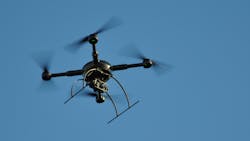How to Add Drone Policy and Procedure to Your Department
Some years ago the mainstream media caught the public’s attention by reporting extensively on how the military was using drones to target and neutralize various enemy targets. During that time frame, almost every time the public heard or read the word “drone,” it was couched to mean something that looked like a flying missile, equipped with advanced weaponry, programmed and released in hunter/killer mode and devastating to the enemy. Of course, with that perception, when it was reported that any law enforcement agency had acquired a drone for use, there was public outcry, “What could any law enforcement agency possibly need with an armed drone?”
Law enforcement’s drone usage and needs varies from that of the military. The common image of an armed military drone being deployed for “wetwork” isn’t one we in law enforcement need, have or use. Yet our communities ask, “What kind of drone(s) does the police/sheriff department have?”
Drones for hobby and professional use
Drones come in many sizes and shapes. Some (nano-drones) are as small as a quarter. Others can be the size of a fighter jet. For the purposes of our discussion here, we’re going to focus on single-user drones that are commonly used by hobbyists and law enforcement agencies.
The laws for using such drones are relatively new. The Academy of Model Aeronautics (AMA) developed training programs for drone pilots and today the AMA works hand in hand with the Federal Aviation Administration (FAA) to ensure drones are flown responsibly and without increasing risk to other aircraft or to people/property on the ground. An unfortunate reality is that anything that can fly can also crash and even with some small drones, if it’s plummeting to the earth at terminal velocity, it can do some damage.
As recently as 2015, the commercial use of a drone was prohibited by FAA rules. When I found that out it made me pretty curious for one simple reason: I knew people and police agencies prior to 2015 who were flying drones for hobby, commercial and professional purposes. If you remember three years ago, drones were one of the hottest Christmas presents a teenager could get. They were sold in every big box store and almost every one of them had an on-board camera. The camera could either capture video or still photographs and either feed it directly to a phone/tablet type device or be downloaded from a memory card once you got the drone back on the ground. So how was all that being done prior to 2015? Illegally is one word a few FAA people might use.
During the time frame of 2007 through 2015, if a drone was to be used for a commercial purpose, a Certificate of Waiver or Authorization (COA) had to be acquired. In 2012, thanks to political pressure from both commercial and private parties, Congress passed the FAA Modernization and Reform Act of 2012. The Act not only prohibited the FAA from creating any rule or regulation that would manage recreational use of drones, but also required the FAA to develop a plan to safely integrate civil unmanned aircraft systems into the national airspace.
For all that, in 2013, commercial UAV (drone) licenses were granted on a case-by-case basis and in 2014 as few as ten applications from commercial companies for drone licenses were approved. Today, a number of commercial industries use drones. Those industries would include commercial photography and videography, surveying, search and rescue services and emergency management intelligence gathering, among other industries. Drones have also been used by the media for aerial coverage of events, and to provide internet connectivity via mesh networks to remote areas.
Congress told the FAA to have a plan for integrating commercial use of drones into the national airspace no later than two years ago. But far more importantly were the existence of restrictions or regulations on our use of drones for a myriad of purposes to include surveillance, pre-operation intelligence gathering, search and rescue and more.
Drone usage increases in law enforcement
Before you even get to the point of considering legal impact, you need to identify your agency’s need for a drone (or drones) and then proceed with a plan to put them into efficient use. How law enforcement uses drones varies greatly from one jurisdiction to the next depending on such things as how rural or urban an area is, how much local air traffic there already is and how much space you have to take off, land and practice.
Once you know what kind of drone best suits your agency, you next need to determine all of the ways in which your agency intends to use said drone. Don’t think for one minute that there is a single part of your agency that doesn’t have a use for a drone. Everyone from your D.A.R.E. officer to your SWAT team commander and even your crime prevention/community relations folks will want air time. Before you put a drone into use you’ll have to determine the priorities of order that each segment of your agency will get drone use time. Additionally, you’ll have to assign an officer (or several) to maintain the unit and be trained on it. That training doesn’t just include flight training, but also legal restrictions, training in any software necessary, FAA regulations, local ordinances and more.
On the subject of flight training though, many of us assume none is necessary. After all, big box stores sell drones and seven year olds fly them, right? How hard can it be? The more complex your system, the more careful and skilled you need to be to fly it. After all, as was stated earlier, everything that flies can crash and when you’re flying your agency’s $1,000 drone system you don’t want to be the one responsible for crashing it. Nor do you want to be responsible for any damage it causes to whatever it crashes on/into and the loss of any evidence it was in the process of gathering.
Yes, flight training is mandatory. Training in the legalities of using the drone to gather intelligence, take pictures and capture video is necessary. Training regarding where you can fly your drone, how high and more—it’s all required. And after the appointed officer has had all that training, you know what comes next, right? Not flying. Writing the agency’s drone use policy.
Creating a comprehensive use policy
Once you are your agency’s “expert” on drone use—which you will be just as soon as you finish training with it—your administration will expect you to write a comprehensive use policy. Before you do that, do your research. Department policy will need to cover:
- Personnel structure of the drone unit
- The primary and secondary missions of the unit
- Where the drone may be flown or is restricted from
- Where the drone will be, under what conditions or authorizations
- If there are any requirements to when any segment of your agency can request use of the drone, either directly or in a support role
- Where the drone will be stored, under whose control and when access for use, maintenance or training is permitted
After you’ve purchased the drone, taken the training and developed (and gotten approved) the policy, now you can finally start flying the thing.
- Where?
- How often?
- For what purpose?
If you don’t know the answer to those questions, go back and review the policy. Remember that using a drone for surveillance is just like any other tool. If there are privacy considerations, private property concerns, etc., seek that warrant you would get if you were gathering any other evidence from the same location.
Make sure your drone program doesn’t become a hobby for the police department. Keep the usage professional and efficient. The aerial photo and video capability of the drone can greatly increase your agency’s ability to perform better at certain tasks. Do the research and carefully review your agency needs before you make a purchase. Stay on top of the on-going changes in FAA policy regarding drones and make sure you stay in compliance with any local ordinances or agency policy.
About the Author
Lt. Frank Borelli (ret), Editorial Director
Editorial Director
Lt. Frank Borelli is the Editorial Director for the Officer Media Group. Frank brings 20+ years of writing and editing experience in addition to 40 years of law enforcement operations, administration and training experience to the team.
Frank has had numerous books published which are available on Amazon.com, BarnesAndNoble.com, and other major retail outlets.
If you have any comments or questions, you can contact him via email at [email protected].

